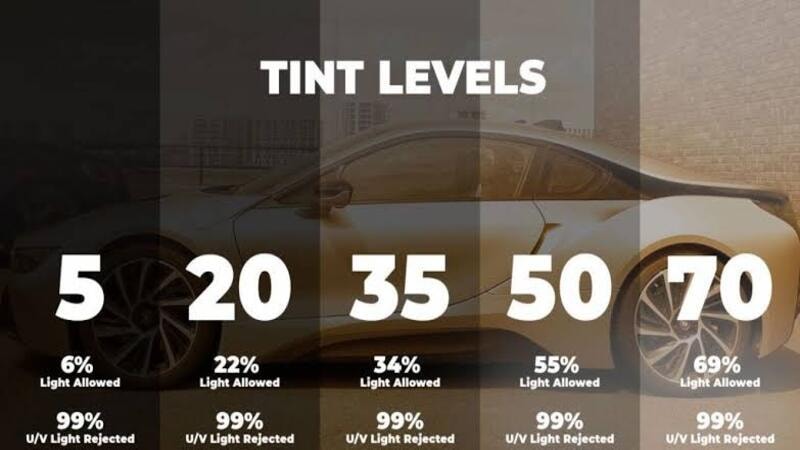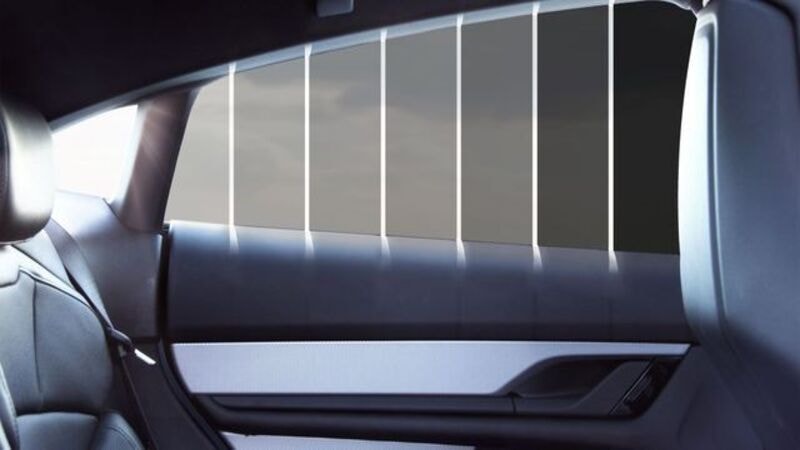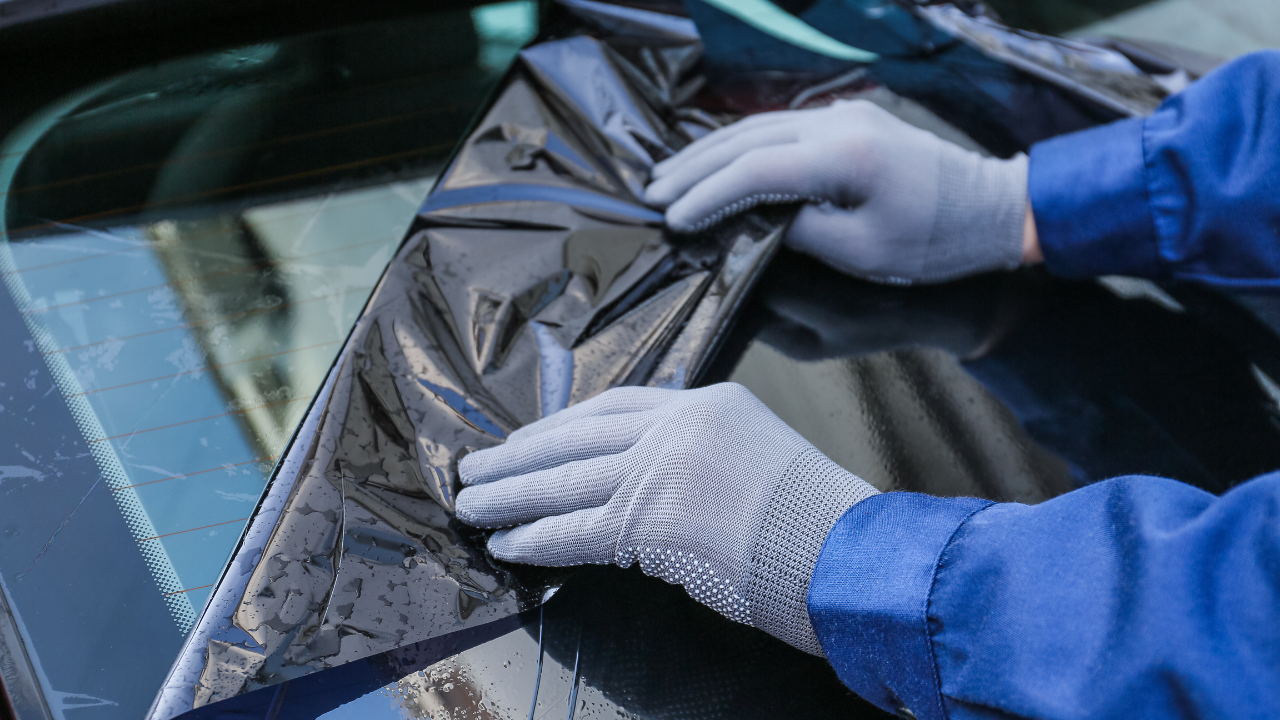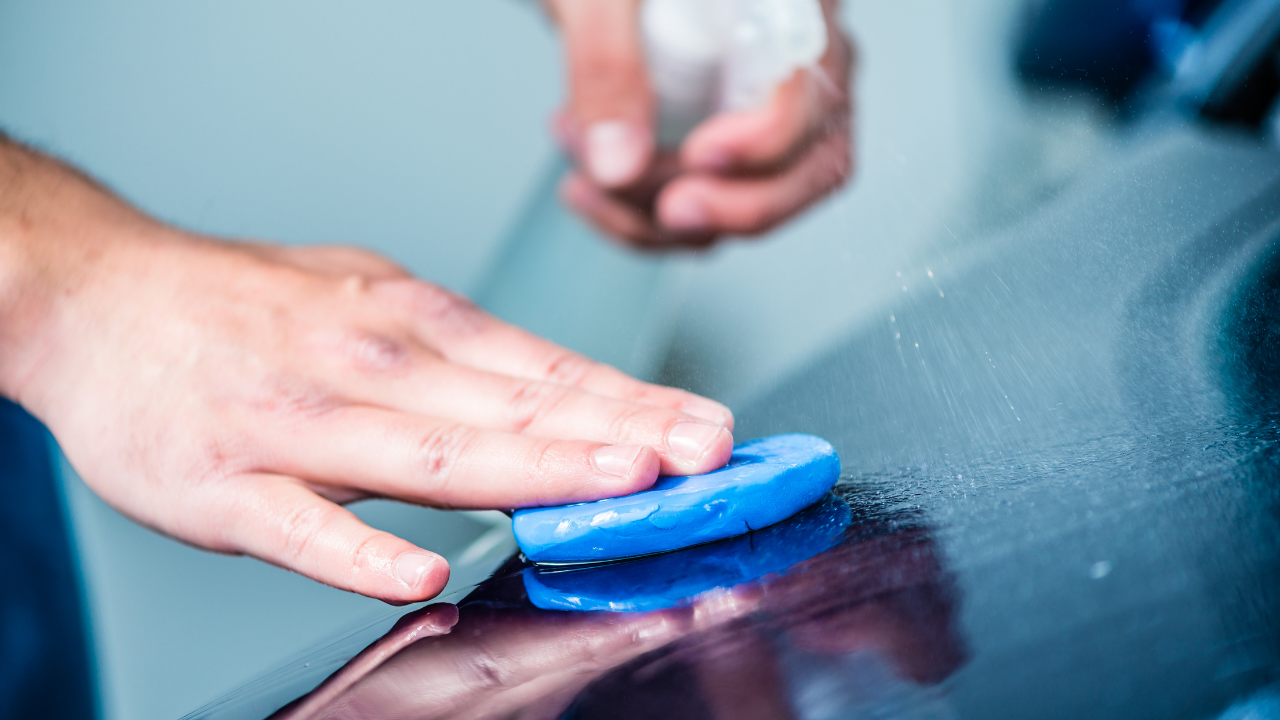Looking to enhance your car’s privacy, block UV rays, or refresh its style? It’s essential to know the nuances of different tint percentages. This post will help you get insights on the benefits, legalities, and expert tips to choose the perfect tint for your vehicle. So, without further ado, let’s get into it!
What Is a Window Tint Percentage?
Window tint percentage refers to the visible light that can pass through your car’s tinted windows. It is expressed as a Visible Light Transmission (VLT) percentage.
Essentially, the lower the window tint percentage, the darker the windows are tinted, meaning less light will enter through them.

Understanding these percentages is crucial when choosing the right tint to meet your needs for privacy, UV protection, and compliance with local tinting laws.
Different Window Tint Percentages
Choosing the right window tint percentage for your vehicle is crucial for meeting your needs and staying within legal limits. Let’s break down the different window tint percentages to help you make an informed choice for your vehicle.
| Tint Percentage | Description | Ideal For | Legal Considerations | Pros | Cons |
|---|---|---|---|---|---|
| 80% Window Tint or More | Very light, blocking 20% of visible light. | Delivery trucks, driving instruction vehicles. | Generally legal everywhere. | Excellent visibility Minimal alteration to appearance Some UV protection | Very little privacy Limited heat reduction |
| 70% Window Tint | Allows 70% of light into the vehicle, providing a light shade. | Front-side windows, passenger cars, vans. | A good compromise between visibility and privacy is Moderate heat and UV reduction | Reduces glare More UV protection than 80% Good visibility | Less privacy than darker tints May not meet heat reduction needs |
| 50% Window Tint | Blocks half of the sun's glare and incoming light. | Both front windshield and rear windows. | Noticeable glare reduction enhances privacy. | It is legal in most states to have front windows. | It may be too dark or light for some drivers. Reduced visibility in low light |
| 35% Window Tint | Personal vehicles prioritize privacy and sun protection. | Personal vehicle windows. | Typically legal for rear and side windows in many states. | Enhanced privacy Significant glare reduction UV protection | Difficult to see through at night or in low light. It may not be legal on front side windows |
| 20% Window Tint | Dark, blocking 80% of external light. | It's not universally legal, especially for front windows. | It completely blocks all visible light (blackout effect). | Excellent privacy Highly effective UV and heat reduction | Difficult to see through at night or in low light. It may not be legal on front side windows |
| 5% Window Tint | Exceptionally dark, allowing only 5% of light (limo tint). | Private cars, limousines. | Maximizes privacy and security. Best for glare and heat reduction | It is often illegal to open driver and passenger windows in many regions. | Illegal vehicle windows. |
| 0% Window Tint | It is generally legal everywhere. | Non-automotive applications, commercial or private stationary installations. | It completely blocks all visible light (blackout effect). | Complete privacy Highest UV and heat protection | Impossible to see through Dangerous for any on-road vehicles |
80% Window Tint or More:
An 80% tint is very light, blocking only 20% of the visible light. It is suitable for drivers who prefer minimal tinting while still getting some protection against UV rays.

It is ideal for vehicles where maximum visibility is necessary, such as delivery trucks and cars used for driving instruction.
This level of tint is generally legal everywhere and is ideal for maintaining maximum visibility, especially suitable for vehicles used in regions with less intense sunlight.
70% Window Tint:
The 70% window tint films allow 70% of the light into the vehicle, providing a light shade on the front windshield that reduces glare while allowing clear visibility.
It is a common choice for front-side windows in many regions due to its balance of light allowance and protection. It is suitable for all types of vehicles, including passenger cars and vans.

Most states allow this tint level on front windows, legally making it a safe choice. Given its safety and legal acceptance in countries like the UK and Japan, it is ideal for drivers needing slight tinting without significant obstruction of view.
50% Window Tint:
A 50% tint blocks half of the sun’s glare and incoming light.
This moderate level of tinting is excellent for drivers seeking more privacy and UV protection without significantly darkening their windows.
It is often used on both the front windshield and rear windows and is legal in most areas, but local regulations must always be checked.
30% Window Tint:
Tinting your passenger rear side windows with a 30% film provides a noticeable glare reduction when in light, enhancing privacy and reducing glare significantly.
It’s a popular choice for all personal vehicle windows and is typically within the legal tint percentage range for many states, especially for rear and side windows.

20% Window Tint:
With a 20% tint, your windows will be pretty dark, blocking 80% of external light.
This tint percentage is favored for personal vehicles where privacy and sun protection are a priority. However, it is not universally legal, particularly for front windows, so verifying local laws in your state before applying this level is crucial.
5% Window Tint:
A 5% tint is exceptionally dark, allowing only 5% of light through. This tint, also called “limo tint”, is permitted to be applied to limousines.
This dark tint offers maximum privacy and is best suited for private cars, limousines, and other private vehicles.
Due to its low visibility, it is often illegal to use on driver and passenger windows in many regions, including several US states.
0% Window Tint:

A 0% tint completely blocks all visible light from entering the windows, creating a blackout effect.
While it provides ultimate privacy and protection, it is illegal for vehicle windows as it severely restricts driver visibility. This tint is only used for specific non-automotive applications.
It is typically used for non-transport purposes, such as commercial or private stationary installations, where privacy and security are paramount.
Window Tint Percentages: Pros and Cons

Selecting the right window tint percentage for your car involves understanding the pros and cons of each level. Here is a breakdown of the pros and cons for various darker window tint percentages:
80% Window Tint Pros and Cons:
Pros :
- Excellent visibility, maintaining clear views both day and night.
- Minimal alteration to the appearance of the vehicle.
- It provides some UV protection without altering window aesthetics significantly.
Cons:
- Offers very little privacy.
- Limited reduction in heat compared to darker tints.

70% Window Tint Pros and Cons:
Pros:
- Reduces glare and eye strain more effectively than lighter tints.
- It blocks more UV rays than 80% tint, offering better protection for passengers and the interior.
- It still provides good visibility for safe driving.
Cons:
- Offers less privacy than darker tints.
- It may not meet the needs of those seeking significant heat reduction.
50% Window Tint Pros and Cons:

Pros:
- A good compromise between visibility and privacy.
- Moderately reduces heat and UV rays, which can protect passengers and the interior.
Cons:
- Some drivers may find it either too dark or too light, not completely satisfying either preference.
- Reduced visibility in shallow light conditions.
35% Window Tint Pros and Cons:
Pros:
- Enhanced privacy while still allowing for safe driving visibility.
- Significant reduction in glare and protection from UV rays.
Cons:
- It can be challenging to see through during night driving or in low-light areas.
- In some regions, it is not legal on front side windows, limiting options.

20% Window Tint Pros and Cons:
Pros:
- It is excellent for privacy, preventing most outside viewers from seeing into the vehicle.
- Highly effective in blocking UV rays and reducing interior heat.
Cons:
- It may significantly impair visibility during nighttime.
- It is often not legal for front windows, leading to fines if misused.
5% Window Tint Pros and Cons:
Pros:
- Maximizes privacy and security, ideal for transporting valuable items or individuals.
- It is best for reducing glare and heat inside the vehicle.

Cons:
- Extremely dark can hinder the driver’s ability to see other vehicles, pedestrians, or road hazards.
- Depending on local laws, it is usually illegal for use on front and sometimes even rear windows.
0% Window Tint Pros and Cons:
Pros:
- Offers complete privacy and the highest UV and heat protection.
- It is ideal for non-road vehicles used in stationary, privacy-sensitive locations.
Cons:
- It is completely dark, making it impossible to see through, thus illegal for any on-road vehicles.
- Eliminates the ability to view outside, which could be dangerous even in non-road situations.

Tips for Choosing the Best Tint Percentage for Your Car
When selecting a window tint percentage for your car, various factors influence your decision, from legal requirements to personal preferences.
Here is an in-depth look at a few factors to help you choose the best window tint percentage for your vehicle:
Understanding State Laws:
The legality of window tints varies significantly from one state’s laws or region to another.
Before you decide on a perfect window tint percentage, it is essential to understand the specific laws in your state or country.
For instance, California permits a maximum of 70% VLT on front-side windows, whereas Texas allows 25%.
Always refer to your state’s Department of Motor Vehicles (DMV) or a reliable online resource for up-to-date regulations to ensure the perfect window tint percentage of your choice is legally compliant.
Type of Vehicle:

The vehicle type plays a significant role in deciding the appropriate tint percentage.
Different types of vehicles often have different tint allowances. For example, passenger vehicles may have restrictions on how dark the front window can be tinted to ensure driver visibility.
In contrast, larger vehicles like SUVs and vans might be permitted to have darker tints due to their design and use.
Purpose of Tinting:
Identify why you are tinting your car windows. If you want to reduce UV exposure, choose a tint like ceramic or carbon film that blocks up to 99% of UV rays.
For privacy, consider darker tints, around 20%. Understand your primary need—protecting your car’s interior, enhancing privacy, or reducing solar heat—and select a car window tint that effectively meets this requirement.
Visibility Needs:

Safety should always be a priority.
Darker tints can significantly reduce visibility, especially during night driving or in low-light conditions. Choosing a tint that maintains adequate visibility is vital for safe driving.
Especially for fleet managers, ensuring comfort and safety for drivers, passengers, and equipment is a primary mission. Investing in window films for fleet vehicles can deliver significant benefits because of their glare-reduction and heat-reducing properties.
Consider lighter tints over 35% if you frequently drive at night or in areas with poor lighting. Choose a tint that ensures adequate visibility, particularly for night driving.
Climate Considerations:

The climate where you live can influence your tint choice.
Tinted films can block over 99% of ultraviolet radiation from penetrating tempered glass. In hotter and sunnier climates, a darker tint might be beneficial to prevent the car interior from heating up and to protect against sun damage. A lighter tint might suffice in more relaxed, less sunny climates, as excessive darkness could impair visibility in already dim conditions.
Aesthetic Preferences:
Your tint decision will also be influenced by personal preference, style, and the look you want to achieve with your vehicle.
Some prefer a subtle enhancement, opting for a lighter tint that doesn’t dramatically alter the car’s appearance. Others may choose a darker shade for a sleeker look that offers more privacy.

Look at examples in person at car dealerships or shows, or view online galleries to see how different tints affect a car’s look. This can help you choose a tint that enhances your car’s style while meeting functional needs.
Longevity and Quality of Tint:
Choose high-quality, window-tinted material to ensure longevity and maximum functionality. Low-quality tints can peel, bubble, or fade over time, which looks unappealing and diminishes the tint’s effectiveness.
Investing in a higher-quality tint will provide better UV protection and heat reduction over the long term. Choose tints like hybrid, carbon, or ceramic films. These materials are more durable and provide better UV protection and heat reduction.
They often come with warranties, especially if installed professionally.
Professional Installation:

Opt for professional installation to guarantee that the tint is applied correctly and lasts.
Professionals can ensure that the tint adheres properly without bubbles or wrinkles and guarantee that the application meets legal standards. Professional installation might seem more costly initially, but it provides durability and legal compliance.
Installation and Maintenance Tips
Proper installation and maintenance are key factors to consider when maximizing the lifespan and effectiveness of your car’s window tint.
Here are essential tips to ensure your auto window tint always remains in top condition and performs as intended.
Tint Installation Tips:
Choose the Right Professional: Always opt for a reputable installer from leading window tint brands with good reviews and proven expertise. Experienced professionals ensure precise application, which is crucial for avoiding bubbles, peeling, and misalignment.
Clean Surface Preparation: Before applying the tint, the windows must be thoroughly cleaned and free of residues. Even tiny particles can cause imperfections, so ensure the surface is impeccably clean.

Quality of Tint Material: Invest in high-quality tint films. Premium materials like carbon or ceramic tints offer better UV protection and do not fade as quickly as cheaper options. They also tend to have better adhesive qualities, which reduce peeling risks.
Understand the Cure Time: Car windows and tints need time to cure after installation. Depending on the climate and the type of car’s windows tinted, this can take several days to a few weeks. During this period, avoid rolling down the vehicle’s windows or using harsh cleaners, as these can interfere with the adhesive setting properly.
Tint Maintenance Tips:
After installing, cleaning your window without damaging the tint requires skills and something crucial to notice.
Regular Cleaning: Use a soft cloth and ammonia-free cleaner designed for tinted windows. Harsh chemicals can damage the tint and cause it to degrade prematurely.
Avoid Sharp Objects: Be cautious with items like seat belts or sharp objects that might scrape against the tint when passing them through the windows. Scratches can permanently damage the tint film.
Inspect Regularly: Check for signs of peeling or bubbling regularly. Early detection of these issues can allow for repair before the damage spreads, which might otherwise require a complete re-tinting.

Sun Exposure: Although window tints are designed to withstand sunlight, prolonged exposure to intense sun can eventually wear down even the best tints. Parking in shaded areas or using a car cover can extend the life of your window tint.
Conclusion
Choosing the ideal window tint percentage needs to balance the privacy, heat reduction, visibility and legal requirements. This guide compares tint levels from 0% to 80%, highlighting pros and cons of each shade. It also provides 8 expert tips for selecting the perfect tint for your needs, plus proper installation and maintenance advice to keep your window tints looking great.
Find Your Perfect Tint Percentage Today!
Struggling to choose the right tint shade for your car? At CarlikeFilm®, we offer a wide range of top-quality window tints tailored to your needs. Our premium films block harmful UV rays, reduce glare, and keep your car interior cool, enhancing your vehicle’s sleek look.
Get a free, no-obligation consultation today! And let our specialists recommend the ideal tint percentage for you. Drive in comfort and confidence—your perfect tint is just a click away!



